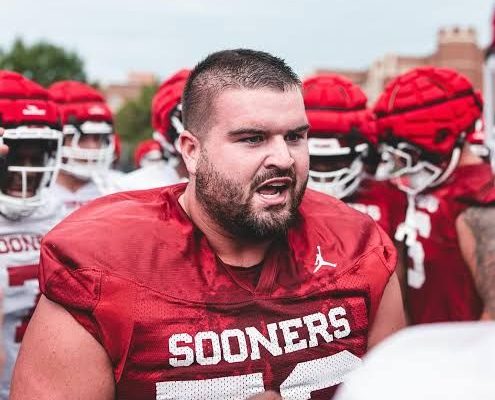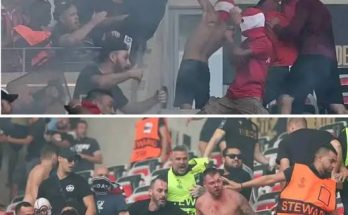JUST IN: Two Oklahoma Sooners star players have found themselves at the center of a storm that is shaking the very foundations of the program, as revelations about a troubling past involving bullying and discriminatory behavior have come to light, drawing swift and stern backlash from team management, alumni, and fans alike. The incident, which has now been confirmed by multiple insiders within the organization, involves two of the most recognizable names on the roster—players who have not only been instrumental on the field but also served as public faces of the team in recent seasons. The resurfacing of these allegations has sent shockwaves across the college football landscape, reigniting conversations about athlete conduct, institutional responsibility, and the balance between winning and ethics in high-stakes sports environments. Reports indicate that the controversy began brewing late last week when screenshots, testimonies, and archived social media posts from several years ago were compiled and circulated online, depicting the players engaging in acts of verbal harassment, exclusion, and discriminatory remarks toward fellow students and teammates during their high school years and early college days. While some of the content appears to be years old, the nature of the allegations—coupled with the fact that both players are now highly visible representatives of Oklahoma football—has made it impossible for the athletic department to ignore. Sources close to the situation say that head coach Brent Venables and other members of the coaching staff were blindsided by the depth of the accusations, although whispers about “immaturity issues” surrounding both players had been around for a while. The university’s compliance office and athletic administration have reportedly convened multiple closed-door meetings to assess the damage and determine the appropriate response. What complicates matters further is that these are not role players or fringe athletes—they are stars, with one projected to be a first-round NFL draft pick and the other already a fan favorite due to his highlight-reel performances. In a sport where talent often buys second chances, the question now is whether Oklahoma will follow through with meaningful accountability or fall into the trap of protecting its on-field product at the expense of its principles.
Fan reaction has been swift and polarized. Many supporters, particularly alumni and boosters who take pride in the “Sooner Standard,” have expressed deep disappointment, urging the program to take a firm stance that aligns with the university’s stated values of respect and inclusion. Others, however, have rallied to the players’ defense, pointing to their on-field contributions, insisting that people can change, and framing the backlash as a form of “cancel culture” that unfairly punishes them for youthful mistakes. This divide has spilled over into social media, where hashtags calling for suspensions trend alongside others demanding forgiveness and a second chance. Former players have also weighed in, some sharing their own stories of locker-room culture and warning that enabling toxic behavior, even in the name of team unity, can have long-term consequences for both individuals and the program.
Inside the program, tension is reportedly high. Teammates are caught in a difficult position—on one hand, they rely on these players to lead the team into a season where expectations are sky-high; on the other, the controversy has disrupted the unity and trust within the locker room. A few players have anonymously expressed frustration, noting that while the accused have shown growth in recent years, the resurfaced behavior is difficult to defend. Others believe the program should protect them, citing the intense pressures and mistakes young athletes make under the spotlight. For the coaching staff, the dilemma is just as complicated: disciplining the players too harshly could derail a promising season, but failing to act decisively risks alienating a fanbase and recruiting class that values integrity as much as success.
The timing of this scandal could not be worse for Oklahoma. With the program preparing for its move to the SEC, national attention is already heightened, and the Sooners’ image as a top-tier, respected powerhouse is crucial for attracting recruits and competing with the likes of Alabama, Georgia, and LSU. Rival programs are watching closely, and it’s not lost on anyone that negative press of this magnitude could be used against Oklahoma on the recruiting trail. In fact, some recruiting analysts have already speculated that high school coaches and parents may steer their top prospects elsewhere if the university is perceived as lax in addressing serious character concerns.
From a legal and procedural standpoint, the university is treading carefully. Athletic compliance officials are said to be consulting with the Title IX office, university legal counsel, and public relations experts to ensure any action taken is both appropriate and defensible. While the incidents occurred before the players’ current tenure at Oklahoma, the NCAA’s evolving approach to athlete conduct, coupled with the university’s own code of conduct, leaves room for internal discipline if the behavior is deemed incompatible with the values of the athletic program. Potential consequences range from mandatory counseling and community service to game suspensions or even removal from the roster, though the latter is seen as unlikely unless new, more damning evidence emerges.
This scandal has also reignited a broader conversation in college athletics about the vetting and character evaluation process in recruiting. Critics argue that universities too often prioritize physical talent over personal integrity, leading to situations where issues from a player’s past are overlooked or dismissed until they explode in public view. In response, some have called for stricter background checks, more thorough interviews with former coaches and teammates, and a more holistic evaluation of recruits that goes beyond highlight tapes and combine stats. For Oklahoma, this could mean reevaluating not only how they select players but also how they mentor them once they arrive on campus.
National sports media has seized on the story, with commentators on ESPN, Fox Sports, and major podcasts debating whether the Sooners’ handling of the matter will define the early SEC era for the program. Some pundits have warned that in the cutthroat world of college football, appearing soft on misconduct can be just as damaging as losing games. Others argue that the real test will be whether the players themselves step up, take accountability, and use their platforms to demonstrate genuine growth and change. So far, both athletes have issued carefully worded statements through the team’s public relations department, acknowledging past mistakes, expressing remorse, and emphasizing their commitment to becoming better leaders. However, critics have noted that the statements lack specific acknowledgment of the incidents in question, which some see as an indication that the responses were more damage control than heartfelt apology.
For the fans who have followed these players from their freshman debuts to their current stardom, the revelations are jarring. In college towns like Norman, athletes are more than just players—they are woven into the cultural fabric, representing the pride and identity of the community. The idea that two of the team’s brightest stars may have engaged in bullying and discrimination runs counter to the image the program works so hard to cultivate. This disconnect between public persona and private behavior is not unique to Oklahoma, but it is particularly painful in a program that markets itself as a leader both on and off the field.
The coming weeks will be critical in determining the long-term impact of this controversy. The university must balance its obligation to uphold its values with the realities of managing a competitive football program in one of the most pressure-filled environments in sports. The players must decide whether to confront their pasts head-on or continue to rely on carefully managed narratives. And the fans must wrestle with their own feelings about redemption, accountability, and the role sports heroes play in shaping community identity.
If handled with transparency, compassion, and firmness, this could become a teachable moment for the program—a chance to reaffirm that the Oklahoma Sooners are about more than wins and championships. But if mishandled, it risks becoming a stain on the program’s legacy, one that rivals will exploit and that could haunt the Sooners for years to come. In the end, the real question may not be whether these two players can overcome their past, but whether the program itself can emerge from this controversy with its integrity intact and its reputation untarnished. The football season may be decided on the field, but the soul of the program will be tested in how it responds to this moment off of it.



